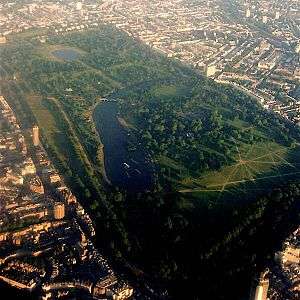Highbury Fields
Coordinates: 51°33′1″N 0°6′6″W / 51.55028°N 0.10167°W

Highbury Fields is an open space in Highbury, in the London Borough of Islington. At 11.75 hectares (29 acres), it is the largest open space in the borough.[1]
It extends north from Highbury Corner almost as far as Highbury Barn. Besides parkland, Highbury Fields contains recreational facilities including tennis courts and Highbury Pool, which reopened after refurbishment in January 2007.
Georgian and Victorian terraces
The elegant houses surrounding the Fields are good examples of Georgian and Victorian town houses and are highly desirable residences. These terraces lie on three roads: Highbury Place, Highbury Crescent, and Highbury Terrace.
John Dawes bought much of the demesne and began the residential development of Highbury. He granted leases in 1774-9 for 39 houses on Highbury Place. These were designed and built by John Spiller, a speculative builder of Southwark. The terrace was completed in 1777. Famous residents include:[2][3]
- 1. Walter Sickert, the Impressionist painter, lived here and ran a rather unsuccessful school for artists at from 1927-31.
- 22. This became the home of Charles, the character played by Hugh Grant in Four Weddings and a Funeral.
- 25. John Wesley stayed here.
- 25. Joseph Chamberlain lived here from 1845-54.
- 39. John Spiller moved in when the terrace was completed in 1777.
- ??. Abraham Newland, chief cashier of the Bank of England, never slept out of it for 25 years. His house on Highbury Place was for daytime use only.[4]
The next major development around what was to become Highbury Fields was the construction of Highbury Terrace. The central part of the terrace dates to 1789. By 1794 nos. 1-16 had been built.[2]
Highbury Crescent was begun in 1844, when land was laid out for it by James Wagstaff and James Goodbody. Nos. 19-25 were let to Goodbody in 1846. The houses were pairs of large Italianate villas, with rich and varied decorations in stucco.[2]
War memorial
At the south end of the fields stands a war memorial dating from 1906, featuring a wreath, cannons and the captured standards of defeated enemies. It commemorates Islington residents who fell in the Boer War. Many consider it a fine example of art nouveau.
Nearest station
References
- ↑ http://www.islington.gov.uk/Environment/outdoor/parks/locations.asp
- 1 2 3 'Islington: Growth: Highbury', A History of the County of Middlesex: Volume 8: Islington and Stoke Newington parishes (1985), pp. 37-41. British History Date accessed: 15 May 2007.
- ↑ Museum of London Postcodes Project, N5
- ↑ 'Highbury, Upper Holloway and King's Cross', Old and New London: Volume 2 (1878), pp. 273-79. British History. Date accessed: 15 May 2007.
